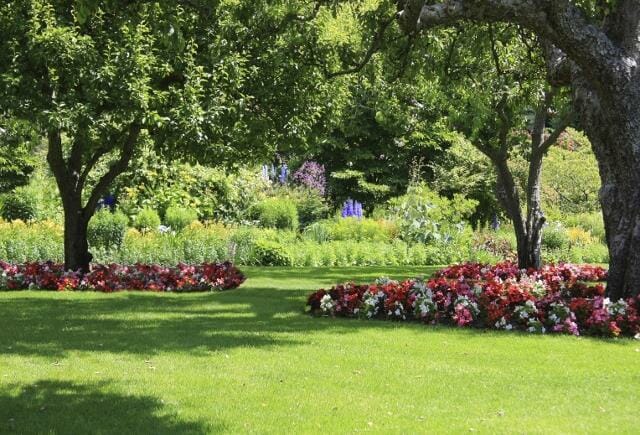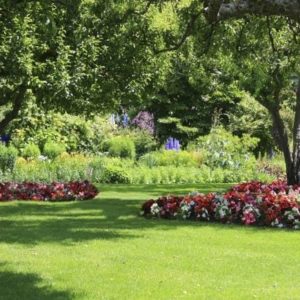
Turf Wars – Trees and Lawns
Turf Wars – Trees and Lawns
Dr. Leonard Perry, Extension Professor
University of Vermont
 A common problem in many landscapes is the competition of trees and lawn for the same light and resources. In many home landscapes, what began as a lush lawn with small trees has become a thin and weedy lawn shaded by many large trees. By knowing what both trees and lawns require for site and maintenance, you can determine if you can have a lawn in the shade of trees and, if so, how.
A common problem in many landscapes is the competition of trees and lawn for the same light and resources. In many home landscapes, what began as a lush lawn with small trees has become a thin and weedy lawn shaded by many large trees. By knowing what both trees and lawns require for site and maintenance, you can determine if you can have a lawn in the shade of trees and, if so, how.
Both trees and lawns are not only attractive in landscapes, but serve many functions. Both trees and lawns produce oxygen, cool the air, stabilize dust, trap air pollutants, and help control erosion. In addition, trees provide shade for buildings in summer and windbreaks, they provide habitat and food for wildlife, and harbor many insects that birds need for food. Lawns provide a groundcover for lower traffic areas, a place to walk and play and entertain.
Both trees and turfgrasses compete for water, nutrients, and light. By reducing this competition, you may be able to have both. Turfgrasses, like many trees, also need good soil drainage to grow successfully.
Most lawn grasses will not grow well if they get less than 50 percent (less than 4 to 6 hours per day) direct sun. One solution to allow more light to grasses below trees might be to eliminate some trees, perhaps weaker and spindly ones. Or you might remove some limbs to allow more light to reach the ground below. If trees are large, this is often a job best left to an arborist. Even removing some lower limbs will allow more light and air, so lessen diseases.
Another option might be to choose more shade tolerant grasses. Fine fescues (such as red, Chewing, hard, and sheep fescues), as well as rough bluegrass, are the most shade tolerant. Fine fescues prefer drier soils and don’t tolerant continually wet soils. For moist, shaded areas consider a rough bluegrass such as the variety Sabre, or supina bluegrass. For moderate to light shade, you can grow tall fescue (the coarse leaf texture doesn’t make it great for home lawns), or some Kentucky bluegrasses such as Glade or America. You may be able to find a seed mixture formulated for shade. Keep in mind, though, that just because a grass or mixture is listed for shade doesn’t mean it will grow perfectly well in dense shade.
While shade above ground is the most obvious limiting factor for grass under trees, the below ground tree roots are equally important to consider. Most tree roots are in the top two feet of soil, contrary to what many think, and most the finer roots that absorb water and nutrients are even more shallow. Grass roots in the full sun occupy much more soil than tree roots, which can be a problem if planting young trees. But under mature trees, the grass is thinner and the roots less dense, so they compete poorly with these tree roots.
Since grass doesn’t grow as vigorously under trees as it does in full sun, the common recommendation is to fertilize at about half the normal rate, or about two pounds of actual nitrogen per 1000 square feet. Fertilizing in fall, after leaf drop from trees, benefits grasses as they are somewhat active then compared to the trees going dormant. Another time you might fertilize grasses is early spring, about a month before leaves appear on trees. Don’t use fertilizers containing herbicides, as they can be taken up by tree roots, and weaken trees over time.
Avoid high nitrogen fertilizers, as they promote succulent top growth. Best are ones with higher potassium (the third number on a fertilizer bag) as this promotes stronger blades more tolerant to wear, and decreases disease susceptibility. Most soils contain sufficient phosphorus (the middle number on a fertilizer bag), so unless called for by a soil test, try not to add this. Excess phosphorus washes into and pollutes waterways in many cases. Many prefer low analysis, organic fertilizers (such as 5-3-4), with their nutrients released over time.
Good culture and the right conditions will help reduce weeds, without using herbicides. A common lawn weed, mosses, indicates the soil is too moist and poorly drained, compacted, with low fertility, acidic, or a combination of these.
In addition to nutrients and light, water is the third factor needed by both lawns and trees. If rain does not measure an inch or more a week, or consists of light showers, water deeply but infrequently. Frequent, shallow watering leads to surface roots that dry out quickly during drought or under tree roots. In my own landscape, soil moisture under trees can be 30 to 40 percent lower (35 to 35 percent soil moisture) than in full sun areas without tree competition.
In addition to dealing with these three main competing factors, mow lawns under trees higher (one-half to an inch higher) than those in full sun. As with any mowing, do so regularly, not removing more than one-third of the blades at any one time. Leave clippings to replenish nutrients and organic matter back into the soil. They won’t cause thatch buildup.
Minimize foot traffic on shaded lawns, as they can’t recover as well as those vigorously growing in full sun. Remove leaves and branches, particularly in fall, promptly. Grass in the shade needs all the light and water and air it can get to avoid stress and diseases. You may need to “overseed” (sow more seeds on top of the existing grass) in early spring every year or two.
If planting new trees in a lawn, make sure they have plenty of space to grow over time, and are far enough (40 to 100 feet for many) apart to allow plenty of light between them. Avoid trees with shallow roots, such as beech, maples and willows. Avoid trees with dense canopies if possible, such as oaks and maples. Lindens (basswood), ginkgo, birches, and poplars are good choices for planting near lawns. On the other hand, if establishing a lawn near trees, don’t till the soil as this will damage the shallow tree roots.
In spite of your best efforts, if a lawn just doesn’t perform as you’d like under trees, consider just placing bark mulch under the trees out to below the edges of branches (the “drip line”). At a minimum, placing mulch around trunks, but only an inch or two deep, will keep mowers and weed trimmers from damaging the tender tree bark. Don’t make a “volcano” of mulch up around tree trunks, as this can smother bark and harbor insects.
If you can’t grow grass in the shade, but want plants and not mulch in an area which won’t get foot traffic, consider groundcover perennials. If such areas are large and you want to walk through them, consider a combination of groundcover with mulched paths. Perennial vinca (where not root invasive), pachysandra or spurge, creeping foamflowers, lily of the valley, barren strawberry, ferns, and ajuga or carpet bugle might be used. Just make sure they don’t escape into adjacent lawn areas, as some like the carpet bugle can take over these areas too.
Receive your complimentary Relocation guide and magazine


